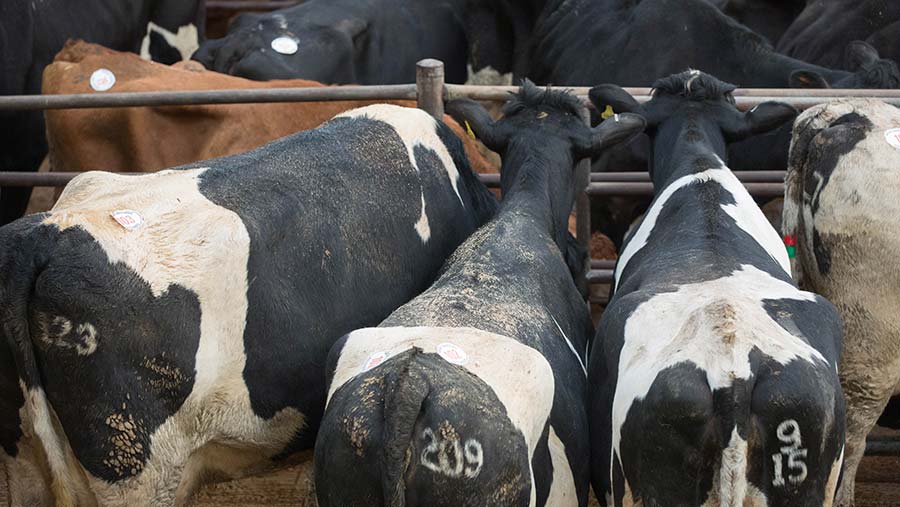National cow shortage pushes up cull prices
 © Tim Scrivener
© Tim Scrivener Phenomenal and at times record cull cow prices have been unable to coax more cows to market, as auctioneers report a national average price of 132.88p/kg to start June.
This leaves cows at least £100 a head dearer after starting the year at 110p/kg, as even the poorer sorts make 90p/kg.
However, auctioneers say TB restrictions mean many are being sold deadweight.
The AHDB also reports that deadweight supplies may be tightening. Its figures show liveweight throughputs are back 19.8% on the year for the four weeks from 12 May. And slaughter figures for May (8,500-9,000 head) are down on April’s weekly totals of just over 10,000 head.
See also: How to prevent fertility issues in dairy cows due to lameness
Gisburn
Gisburn’s cull throughputs are decreasing as TB restrictions start to affect cattle trading in Lancashire. Cull cows met a flying trade on Thursday (31 May), including an astonishing bid of £1,600.60 for a trade-topping continental cow, with 59 culls averaging £854 overall.
Best beef cows made 157.9p/kg, 22 primes made 130p/kg, 29 dairy cows made 121p/kg and leaner cows made 98.5p/kg.
“It’s the trade there for the lean cows that is astonishing,” dairy auctioneer Fred Spurgeon says.
He says he hasn’t seen a cow at 80p/kg or less for a long time.
“We would expect to see nearer 100 cows a week really, so numbers are down. About 20 mart regulars are currently under TB restriction.”
Mr Spurgeon says increasing TB restrictions in northern England is limiting the number going live. “At £25 to test an animal, you’re not going to test a cull cow – you can send it deadweight instead.”
Market Drayton
Barbers throughputs are also 50-80 head down on the year at Market Drayton. This is helping trade hit some big prices – sucklers have topped at 190p/kg and dairy culls hit 160p/kg recently (4 June).
Auctioneer and partner Mark Jones has seen numbers drop over the past six or seven years from highs of 600-650 to 200-250 since red markets started, with 124 reported last week.
He says there is less interest in buying feeding cows, with good prices leading to cows being cashed and culled earlier.
“One issue is that for the larger dairies a fortnightly mart isn’t often enough if they are under TB restrictions, so they opt to sell deadweight instead,” says Mr Jones. “There have been a few vendors who have been tempted back to the mart with the trade as good as it is for all types of cows, although some have been lost for good, it seems.”
Dumfries
Fodder shortages forced people to sell cows in south-west Scotland earlier in the year, leaving supplies tight, prices high and a very firm outlook for the rest of the summer.
This is according to Harry Begg of C and D Auction Marts, who is regularly seeing leaner cull cows over 100p/kg and generally over 90p/kg.
Throughputs through January to April were up to 80-120 head a week, but are now down to 50 head, which is reflective of typical summer throughputs.
A small number of Irish bidders were helping trade, sometimes taking 50-60% of the yarding, Mr Begg adds.
“I see no reason why the price will drop at all. I think cow numbers will remain tight for the rest of the summer.”
